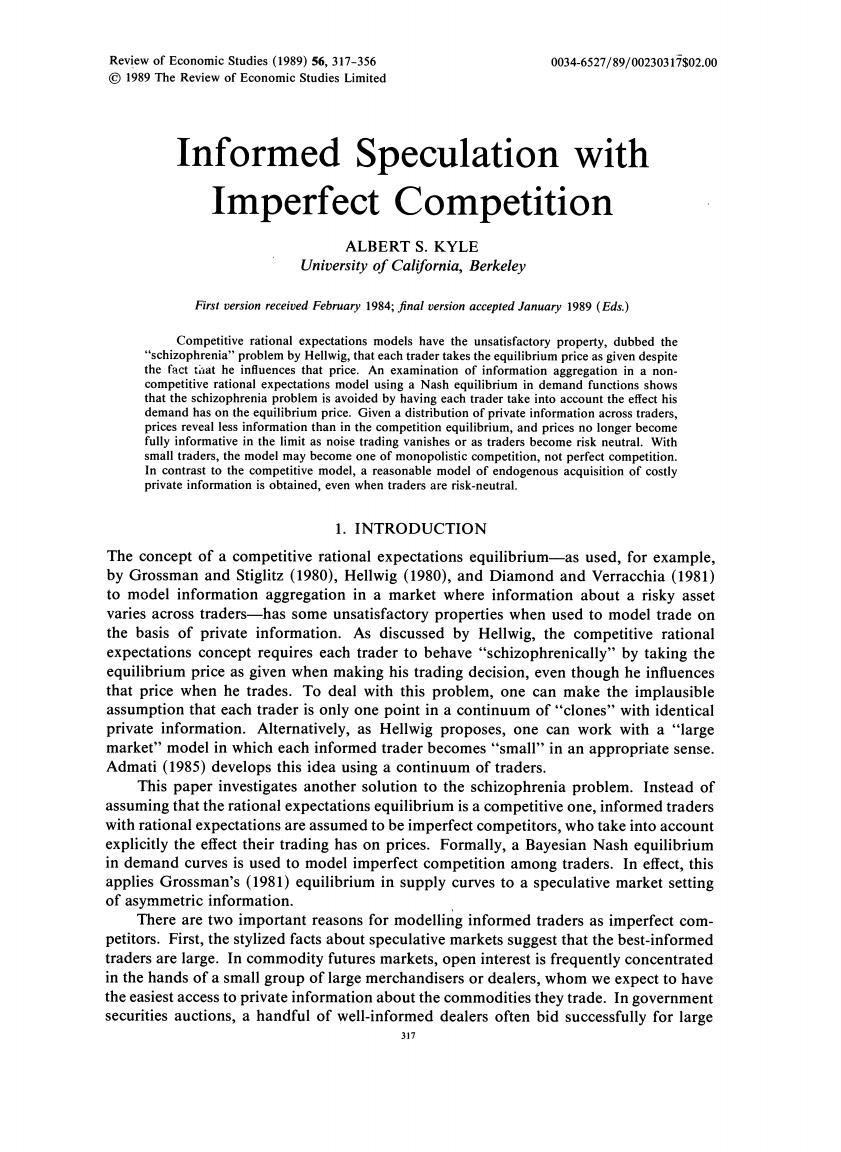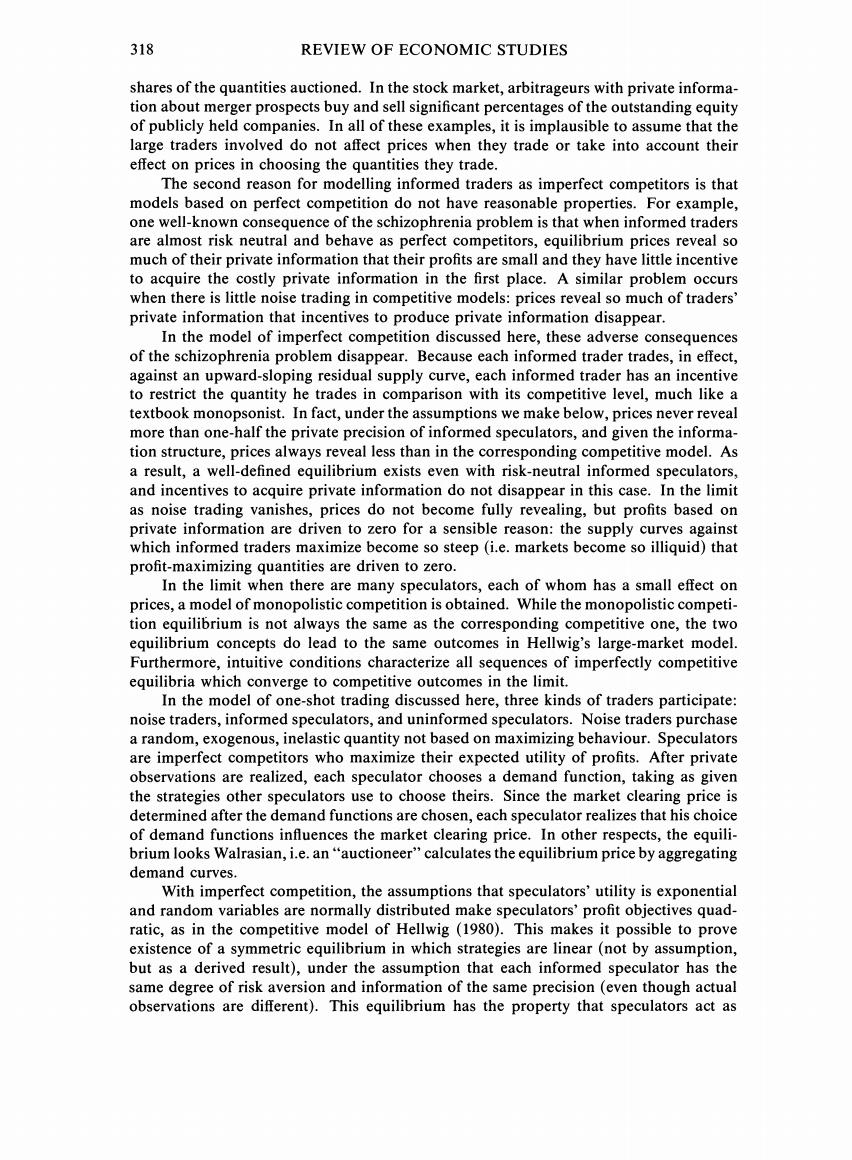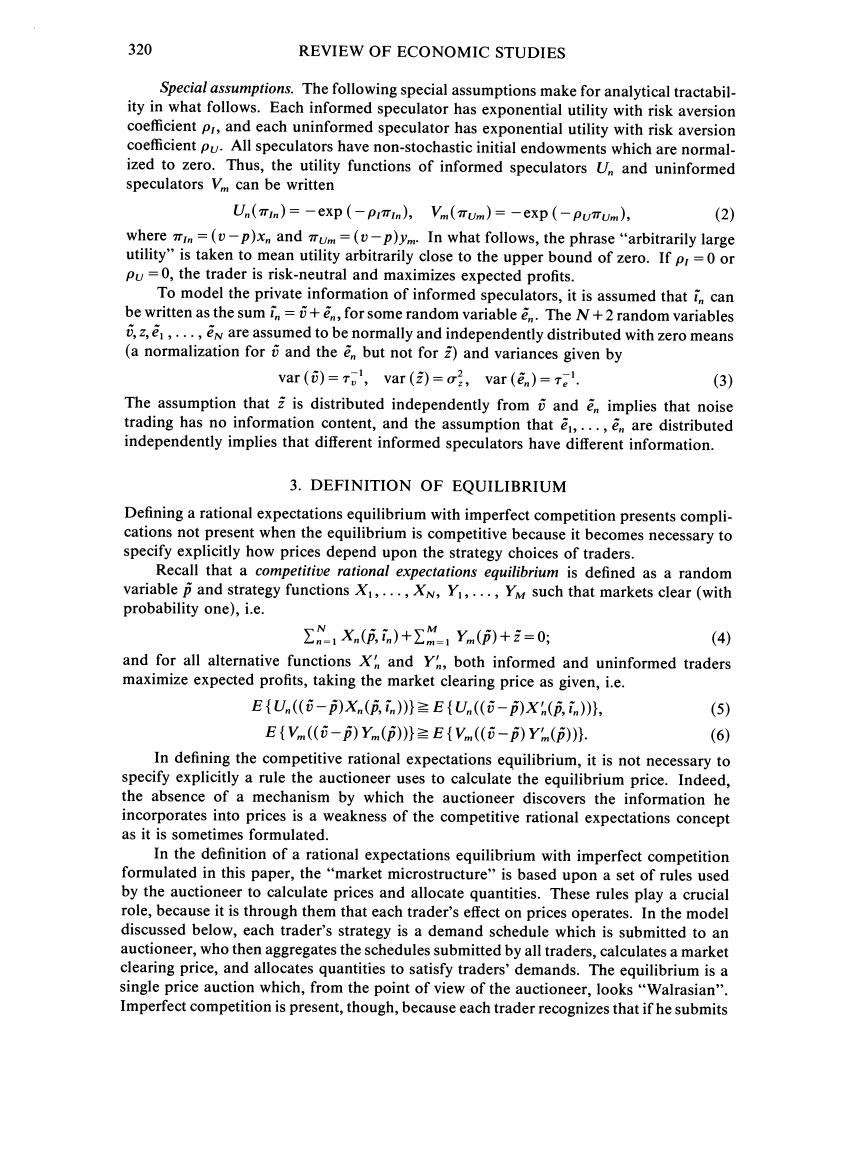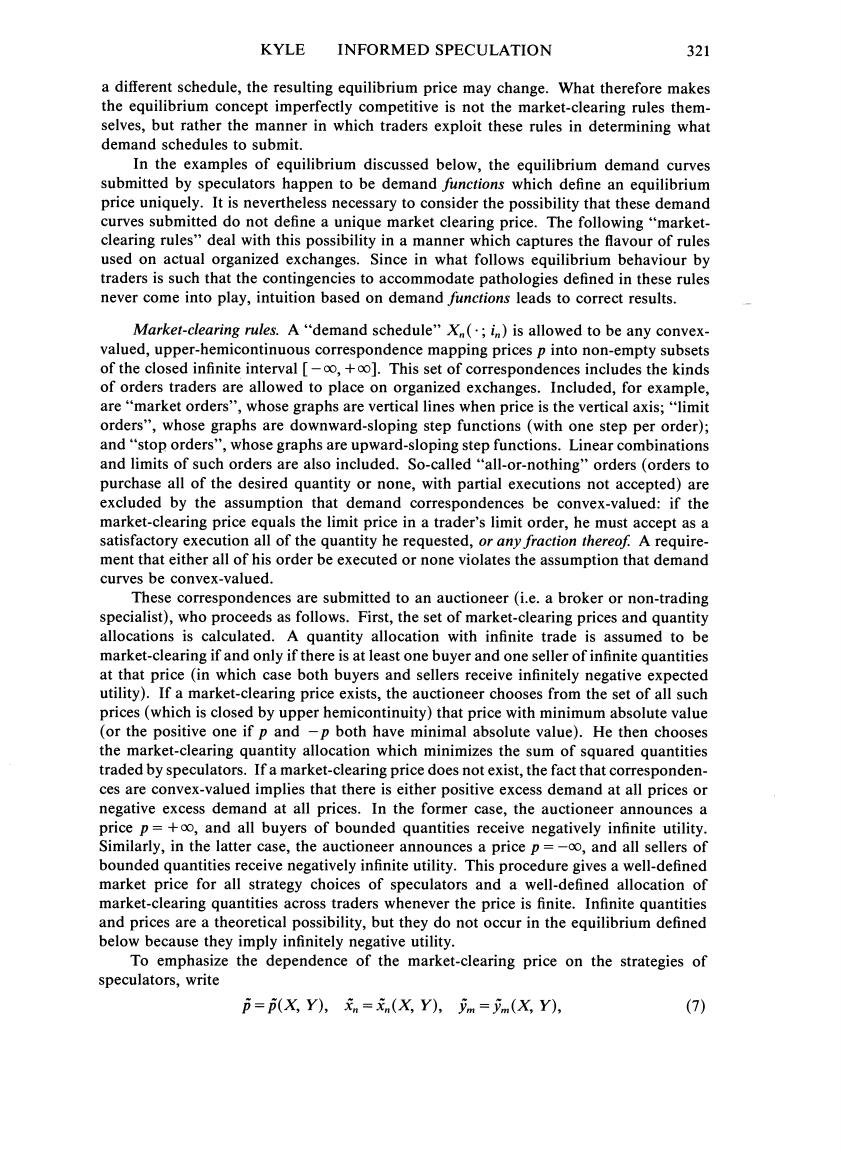
Review of Economic Studies (1989)56,317-356 0034-6527/89/00230317$02.00 C 1989 The Review of Economic Studies Limited Informed Speculation with Imperfect Competition ALBERT S.KYLE University of California,Berkeley First version received February 1984;final version accepted January 1989 (Eds.) Competitive rational expectations models have the unsatisfactory property,dubbed the "schizophrenia"problem by Hellwig,that each trader takes the equilibrium price as given despite the fact tiat he influences that price.An examination of information aggregation in a non- competitive rational expectations model using a Nash equilibrium in demand functions shows that the schizophrenia problem is avoided by having each trader take into account the effect his demand has on the equilibrium price.Given a distribution of private information across traders, prices reveal less information than in the competition equilibrium,and prices no longer become fully informative in the limit as noise trading vanishes or as traders become risk neutral.With small traders,the model may become one of monopolistic competition,not perfect competition. In contrast to the competitive model,a reasonable model of endogenous acquisition of costly private information is obtained,even when traders are risk-neutral. 1.INTRODUCTION The concept of a competitive rational expectations equilibrium-as used,for example, by Grossman and Stiglitz (1980),Hellwig (1980),and Diamond and Verracchia (1981) to model information aggregation in a market where information about a risky asset varies across traders-has some unsatisfactory properties when used to model trade on the basis of private information.As discussed by Hellwig,the competitive rational expectations concept requires each trader to behave "schizophrenically"by taking the equilibrium price as given when making his trading decision,even though he influences that price when he trades.To deal with this problem,one can make the implausible assumption that each trader is only one point in a continuum of"clones"with identical private information.Alternatively,as Hellwig proposes,one can work with a "large market"model in which each informed trader becomes"small"in an appropriate sense. Admati (1985)develops this idea using a continuum of traders. This paper investigates another solution to the schizophrenia problem.Instead of assuming that the rational expectations equilibrium is a competitive one,informed traders with rational expectations are assumed to be imperfect competitors,who take into account explicitly the effect their trading has on prices.Formally,a Bayesian Nash equilibrium in demand curves is used to model imperfect competition among traders.In effect,this applies Grossman's (1981)equilibrium in supply curves to a speculative market setting of asymmetric information. There are two important reasons for modelling informed traders as imperfect com- petitors.First,the stylized facts about speculative markets suggest that the best-informed traders are large.In commodity futures markets,open interest is frequently concentrated in the hands of a small group of large merchandisers or dealers,whom we expect to have the easiest access to private information about the commodities they trade.In government securities auctions,a handful of well-informed dealers often bid successfully for large 317

318 REVIEW OF ECONOMIC STUDIES shares of the quantities auctioned.In the stock market,arbitrageurs with private informa- tion about merger prospects buy and sell significant percentages of the outstanding equity of publicly held companies.In all of these examples,it is implausible to assume that the large traders involved do not affect prices when they trade or take into account their effect on prices in choosing the quantities they trade. The second reason for modelling informed traders as imperfect competitors is that models based on perfect competition do not have reasonable properties.For example, one well-known consequence of the schizophrenia problem is that when informed traders are almost risk neutral and behave as perfect competitors,equilibrium prices reveal so much of their private information that their profits are small and they have little incentive to acquire the costly private information in the first place.A similar problem occurs when there is little noise trading in competitive models:prices reveal so much of traders' private information that incentives to produce private information disappear. In the model of imperfect competition discussed here,these adverse consequences of the schizophrenia problem disappear.Because each informed trader trades,in effect, against an upward-sloping residual supply curve,each informed trader has an incentive to restrict the quantity he trades in comparison with its competitive level,much like a textbook monopsonist.In fact,under the assumptions we make below,prices never reveal more than one-half the private precision of informed speculators,and given the informa- tion structure,prices always reveal less than in the corresponding competitive model.As a result,a well-defined equilibrium exists even with risk-neutral informed speculators, and incentives to acquire private information do not disappear in this case.In the limit as noise trading vanishes,prices do not become fully revealing,but profits based on private information are driven to zero for a sensible reason:the supply curves against which informed traders maximize become so steep (i.e.markets become so illiquid)that profit-maximizing quantities are driven to zero. In the limit when there are many speculators,each of whom has a small effect on prices,a model of monopolistic competition is obtained.While the monopolistic competi- tion equilibrium is not always the same as the corresponding competitive one,the two equilibrium concepts do lead to the same outcomes in Hellwig's large-market model. Furthermore,intuitive conditions characterize all sequences of imperfectly competitive equilibria which converge to competitive outcomes in the limit. In the model of one-shot trading discussed here,three kinds of traders participate: noise traders,informed speculators,and uninformed speculators.Noise traders purchase a random,exogenous,inelastic quantity not based on maximizing behaviour.Speculators are imperfect competitors who maximize their expected utility of profits.After private observations are realized,each speculator chooses a demand function,taking as given the strategies other speculators use to choose theirs.Since the market clearing price is determined after the demand functions are chosen,each speculator realizes that his choice of demand functions influences the market clearing price.In other respects,the equili- brium looks Walrasian,i.e.an"auctioneer"calculates the equilibrium price by aggregating demand curves. With imperfect competition,the assumptions that speculators'utility is exponential and random variables are normally distributed make speculators'profit objectives quad- ratic,as in the competitive model of Hellwig (1980).This makes it possible to prove existence of a symmetric equilibrium in which strategies are linear(not by assumption, but as a derived result),under the assumption that each informed speculator has the same degree of risk aversion and information of the same precision(even though actual observations are different).This equilibrium has the property that speculators act as

KYLE INFORMED SPECULATION 319 monopsonists who observe their residual supply curves and utilize any information which the levels of these supply curves reveal about the liquidation value of the commodity. The plan of this paper is as follows.Section 2 outlines the basic structure,establishes notation,and makes special assumptions.Section 3 defines a rational expectations equilibrium with imperfect competition and provides a conceptual discussion of the particular equilibrium concept chosen.Section 4 introduces some indices measuring informational efficiency;these are useful in discussing both competitive and imperfectly competitive equilibria when linearity is assumed.Section 5 characterizes the unique symmetric rational expectations equilibrium with imperfect competition which has the property that optimal trading strategies are linear.Section 6 contains an analogous characterization of the competitive equilibrium,for the purpose of facilitating comparisons between the two.Section 7 compares the indices measuring the informativeness of prices which result from the two equilibrium concepts.Section 8 discusses the properties of equilibrium when the number of informed speculators is large.Section 9 shows how the model with imperfect competition can become one of monopolistic competition when traders are small,and characterizes all sequences of exogenous parameters in which the competitive and imperfectly competitive concepts have non-trivial,informationally equivalent limits.Section 10 introduces endogenous acquisition of costly private informa- tion,and shows that the strange properties of equilibrium associated with the"informa- tional efficiency"paradox go away when imperfect competition is introduced.Section 11 concludes by suggesting that since the equilibrium with imperfect competition is intellectually sensible and leads to properties different from those of the competitive equilibrium in important respects,its thorough study is justified. 2.STRUCTURE AND NOTATION Trading takes place in a one-period,partial equilibrium framework.A single risky asset is traded at a market clearing price p,realizes after trade occurs an exogenous liquidation value and thus generates returns o-p.Three kinds of traders participate in the market: noise traders,informed speculators,and uninformed speculators. Noise traders trade in aggregate an exogenous random quantity Z,which is not(in this paper)based on maximizing behaviour. There are N informed speculators,indexed n=1,...,N,and M uninformed specu- lators,indexed m=1,...,M.Each informed speculator is endowed with unique private information,represented as the outcome of a random variable in.After observing his private signal in,each informed speculator chooses a demand schedule X(;i)which depends upon that signal.Each uninformed trader chooses a demand schedule Ym(). The schedules X and Ym are the speculators'strategies.Given a market clearing price p,the quantities traded by informed and uninformed speculators can be written xn=Xn(p,in),n=1,...,N;ym=Ym(p),m=1,...,M. (1) In this notation,a tilde distinguishes a random variable from its realization.Thus, denotes the random variable generating the quantity traded by the nth informed trader, and xn is the quantity traded for a particular realization of.Similarly,X(;in)is a random variable defined over demand schedules,while X(,i)is a particular demand schedule corresponding to a particular realization of in.These are both different from X,the strategy rule of the nth informed speculator.We can interpret X either as a mapping from R'to R (i.e.X.=X(,))or as a mapping from R to the space of demand schedules (i.e.X=X(;))

320 REVIEW OF ECONOMIC STUDIES Special assumptions.The following special assumptions make for analytical tractabil- ity in what follows.Each informed speculator has exponential utility with risk aversion coefficient pr,and each uninformed speculator has exponential utility with risk aversion coefficient Pu.All speculators have non-stochastic initial endowments which are normal- ized to zero.Thus,the utility functions of informed speculators U and uninformed speculators Vm can be written Un(TIn)=-exp(-prTIn),Vm(Tum)=-exp (-PuTUm), (2) where Tin=(v-p)xn and Tum =(v-p)ym.In what follows,the phrase "arbitrarily large utility"is taken to mean utility arbitrarily close to the upper bound of zero.If pr=0 or Pu =0,the trader is risk-neutral and maximizes expected profits. To model the private information of informed speculators,it is assumed that in can be written as the sum in=+,for some random variable en.The N+2 random variables ,z,e1,...,ew are assumed to be normally and independently distributed with zero means (a normalization for and the en but not for 2)and variances given by var ()=T,var ()=2,var (n)=Te. (3) The assumption that is distributed independently from and en implies that noise trading has no information content,and the assumption that e,...,e are distributed independently implies that different informed speculators have different information. 3.DEFINITION OF EQUILIBRIUM Defining a rational expectations equilibrium with imperfect competition presents compli- cations not present when the equilibrium is competitive because it becomes necessary to specify explicitly how prices depend upon the strategy choices of traders. Recall that a competitive rational expectations equilibrium is defined as a random variable p and strategy functions X1,...,XN,Y1,...,YM such that markets clear(with probability one),i.e. ,X.(ii)+∑M,y()+=0: (4) and for all alternative functions X and Y,both informed and uninformed traders maximize expected profits,taking the market clearing price as given,i.e. EU((p)xn(p,in)))EU((-p)xh(p,in))), (5) EVm ((-p)Ym(p))Ev((-p)Ym(p))). (6) In defining the competitive rational expectations equilibrium,it is not necessary to specify explicitly a rule the auctioneer uses to calculate the equilibrium price.Indeed, the absence of a mechanism by which the auctioneer discovers the information he incorporates into prices is a weakness of the competitive rational expectations concept as it is sometimes formulated. In the definition of a rational expectations equilibrium with imperfect competition formulated in this paper,the "market microstructure"is based upon a set of rules used by the auctioneer to calculate prices and allocate quantities.These rules play a crucial role,because it is through them that each trader's effect on prices operates.In the model discussed below,each trader's strategy is a demand schedule which is submitted to an auctioneer,who then aggregates the schedules submitted by all traders,calculates a market clearing price,and allocates quantities to satisfy traders'demands.The equilibrium is a single price auction which,from the point of view of the auctioneer,looks"Walrasian". Imperfect competition is present,though,because each trader recognizes that if he submits

KYLE INFORMED SPECULATION 321 a different schedule,the resulting equilibrium price may change.What therefore makes the equilibrium concept imperfectly competitive is not the market-clearing rules them- selves,but rather the manner in which traders exploit these rules in determining what demand schedules to submit. In the examples of equilibrium discussed below,the equilibrium demand curves submitted by speculators happen to be demand functions which define an equilibrium price uniquely.It is nevertheless necessary to consider the possibility that these demand curves submitted do not define a unique market clearing price.The following"market- clearing rules"deal with this possibility in a manner which captures the flavour of rules used on actual organized exchanges.Since in what follows equilibrium behaviour by traders is such that the contingencies to accommodate pathologies defined in these rules never come into play,intuition based on demand functions leads to correct results Market-clearing rules.A"demand schedule"Xn(;in)is allowed to be any convex- valued,upper-hemicontinuous correspondence mapping prices p into non-empty subsets of the closed infinite interval [-oo,+oo].This set of correspondences includes the kinds of orders traders are allowed to place on organized exchanges.Included,for example, are"market orders",whose graphs are vertical lines when price is the vertical axis;"limit orders",whose graphs are downward-sloping step functions (with one step per order); and"stop orders",whose graphs are upward-sloping step functions.Linear combinations and limits of such orders are also included.So-called "all-or-nothing"orders (orders to purchase all of the desired quantity or none,with partial executions not accepted)are excluded by the assumption that demand correspondences be convex-valued:if the market-clearing price equals the limit price in a trader's limit order,he must accept as a satisfactory execution all of the quantity he requested,or any fraction thereof.A require- ment that either all of his order be executed or none violates the assumption that demand curves be convex-valued. These correspondences are submitted to an auctioneer (i.e.a broker or non-trading specialist),who proceeds as follows.First,the set of market-clearing prices and quantity allocations is calculated.A quantity allocation with infinite trade is assumed to be market-clearing if and only if there is at least one buyer and one seller of infinite quantities at that price (in which case both buyers and sellers receive infinitely negative expected utility).If a market-clearing price exists,the auctioneer chooses from the set of all such prices(which is closed by upper hemicontinuity)that price with minimum absolute value (or the positive one if p and -p both have minimal absolute value).He then chooses the market-clearing quantity allocation which minimizes the sum of squared quantities traded by speculators.If a market-clearing price does not exist,the fact that corresponden- ces are convex-valued implies that there is either positive excess demand at all prices or negative excess demand at all prices.In the former case,the auctioneer announces a price p=+oo,and all buyers of bounded quantities receive negatively infinite utility. Similarly,in the latter case,the auctioneer announces a price p=-oo,and all sellers of bounded quantities receive negatively infinite utility.This procedure gives a well-defined market price for all strategy choices of speculators and a well-defined allocation of market-clearing quantities across traders whenever the price is finite.Infinite quantities and prices are a theoretical possibility,but they do not occur in the equilibrium defined below because they imply infinitely negative utility. To emphasize the dependence of the market-clearing price on the strategies of speculators,write p=(X,Y),xn=元n(X,Y),ym=少m(X,Y), (7)